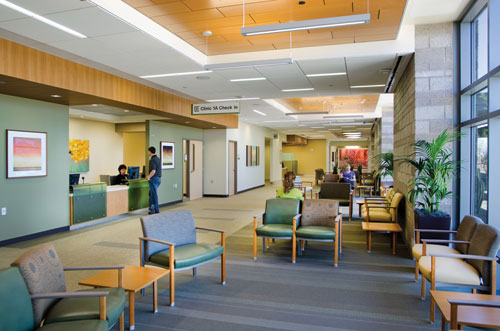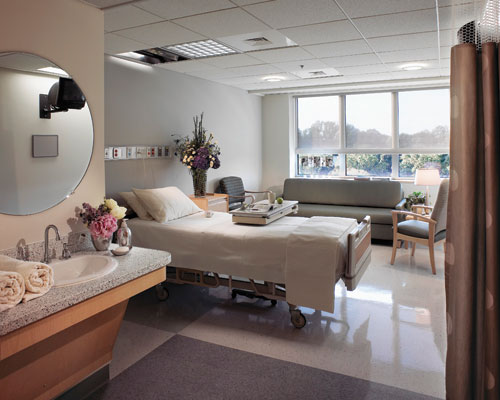Functional Color and Design in Healthcare Environments
GOALS OF HEALING ENVIRONMENTS
There are three principal goals to every healing environment. Healthcare designers strive to heal the patient, support the staff and engage the family. The first goal is to heal the patient. A primary focus is to make sure that patients spend all of their energy fighting the disease—not the healthcare environment. Research reveals that individuals in healthcare settings nationwide agree that privacy, respect as an individual and their safety and security were the highest priorities for their care setting. Implementing EBD design theories that respond to these priorities has shown to improve patient satisfaction.
 |
This colorful, daylit waiting area at Banner Health Clinic in Maricopa, Arizona, is designed by SmithGroupJJR using evidence-based design principles to help provide an atmosphere of comfort. Photo by Gregg Mastorakos: SmithGroupJJR |
Additionally, patients need supportive staff. Healthcare organizations and institutions are finding that they must differentiate themselves to recruit and maintain personnel. When featuring EBD to recruit and retain staff, they are finding that they are elevating themselves in competitive marketplaces.
Finally, family support is essential in therapy, caring and advocating for the patient. Families that are involved in the healing and therapy process respond to EBD environments and are engaged as good advocates for the patient. Healthcare settings that simulate a home environment and engage all of the five senses by design are shown to improve healthcare outcomes and family involvement in the patient care.
Design professionals using EBD have identified 12 aspects of a healing environment that have the ability to be a part of the healing process. These include:
- Single patient rooms
- Ergonomics
- Furniture arrangement
- Air quality
- Windows
- Wayfinding
- Building layouts and zoning
- Access to nature
- Light – particularly natural daylight
- Floor materials
- Noise control
- Positive distraction through the use of aesthetics
Although there is no exact “design medicine,” hospitals with designers who pay attention to these 12 areas achieve results for hospital caregivers. Healthcare design professionals should aim to provide patient's control over their environment and thoughtful accommodations for all caregivers including family members and friends. The cultural and geographic area of the world in which the hospital is located may guide the design direction and aesthetic choices. A hospital with the desert of Arizona in the background may have a very different design direction from one in Paris. Healthcare design that is inspired by the art, craft and culture of place will provide a setting that meets many sustainable design goals.
 |
This inpatient oncology room at Holy Cross Hospital in Silver Spring, Maryland, designed by SmithGroupJJR, simulates a home atmosphere. Photo by Gregg Mastorakos: SmithGroupJJR |









